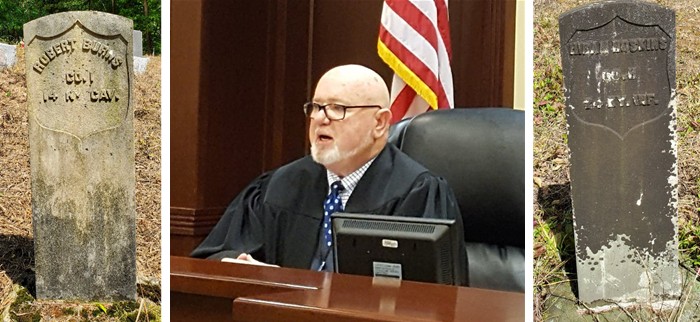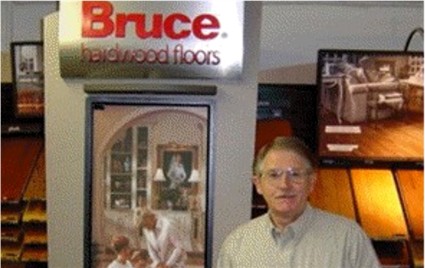70+ Infants, Indians, Civil War and other Veterans, along with many others were buried in the Cemetery during the past 125 years

Photos of Civil War headstones and the Honorable Judge Oscar Gayle House by ClayCoNews
MANCHESTER, KY (July 7, 2022) - According to Stella B. House Attorney at Law, P.S.C., the following statement was Efiled and then read into the record in Clay Circuit Court on Thursday morning July 7, 2022. The statement is in regards to the highly publicized and controversial issue of the relocation of the historical Hoskins Cemetery by the School Board in Clay County. The cemetery is located on Island Creek Hill off U.S. 421 in Manchester.

Historic 125 year old Hoskins Cemetery on Island Creek Hill in Clay County, Kentucky
Statement:

It is a well-established principle of common law that once human remains are intentionally placed in real property, such real property and all subsequent owners are burdened by encumbrances in favor of the dead, the kin of the dead, and the public. The dedication of land for a cemetery is in the nature of an irrevocable covenant running with the land.
It is an implied contractual relationship that bonds the owner irrevocably to the following:
1. The owner cannot remove or disturb any grave.
2. The relatives and friends have unrestricted rights to visit and care for the graves.
3. Cemetery property cannot be used by the owner for any purpose inconsistent with cemetery purposes.
4. The owner cannot reduce the size of the land set apart as a cemetery.
Thus, when human remains are intentionally placed in real property with the consent of the owner, the common law recognizes that the character of such real property has been perpetually transformed. In Law of Cadavers and of Burial and Burial Places, it states that "Whatever may be the mode of acquisition, and whatever the title acquired, once land has been devoted to burial it no longer is subject to mere rules of property law."
Hutchinson v. Akin, an 1871 Kentucky Supreme Court decision, states the rule of law that has been consistently followed by Kentucky courts. It stands for the proposition that, without any reservation or inhibition in the deed, Kentucky law prohibits the Board from removing the stones that mark the resting places of the dead buried there or injuring or removing the enclosure around the graveyard. It also compels the Board to permit the relatives of those buried there to exercise the right of ingress and egress.
In a subsequent decision, Rose v. Rose, the Kentucky courts confirmed that the right of an heir to visit a grave cannot be extinguished by the subservient fee owners through conveyance to another. In this case, the Board is the subservient fee owner. This means that the right of the Plaintiffs and others to visit the graves of the decedents buried in the cemetery cannot be extinguished by the Board.
When the Clay County Board of Education acquired real property from the Hoskins heirs, it was subject to the common law protections afforded to cemeteries. The leading common law case on the subject is Hines v. State. In that case, the Tennessee Supreme Court stated that when land has been appropriated to burial purposes, it cannot be conveyed or devised as other property, so as to interfere with the use and purposes to which it has been devoted. When once dedicated to burial purposes and a burial has taken place, then the owner holds the title in trust for the benefit of the dead and the living, the owner takes the land subject to this trust.
In addition, the Tennessee Supreme Court stated that those who purchase property after it has been appropriated to burial purposes take it subject to the implied rights of the deceased and the living without any express reservation in the deed of conveyance. The Court added, "Burial lots ... are not the subject of trade and commerce, and it is always presumed that they are not included in the sale of property which surrounds them."
In this specific instance, the CCBOE knew that .379 acres of land had been set aside for the Hoskins Cemetery before it purchased this adjoining land. In addition, the board members could see physical signs of the Hoskins Cemetery by virtue of the 75+ tombstones there. As this .379 acres had been set aside for burial purposes, the Hoskins heirs held the title in trust for the benefit of the dead and the living, and the CCBOE purchased the property subject to this trust.
Kentucky’s Constitution §13 requires that private property to be taken only for a “public use”. The law requires that private property be taken in an eminent domain case only for a “public purpose”. KRS 416.540(6). See also, City of Bowling Green v. Cooksey, Ky., App., 858 S.W.2d 190 (1992). The determination of a “public purpose” is decided by the judiciary. Idol v. Knuckles, Ky., 383 S.W.2d 910 (1964). In every Kentucky case, the parties seeking to condemn must meet a two-prong test of “necessity” and “public purpose”. Profitt v. Louisville & Jefferson County Metropolitan Sewer District, Ky., 850 S.W.2d 852 (1993). Therefore,
Plaintiffs, by counsel, state that the Board was required to file an eminent domain or condemnation proceeding under Kentucky Law due to the fact that the living next-of-kin of the decedents buried in the Hoskins Cemetery (the “Cemetery”) own the dominant estate in the property constituting the cemetery, an easement to the cemetery, and easements of the decedents interred in the Cemetery.
No condemnation action or eminent domain proceeding to seize the rights of the easements and dominant estate, belonging to the family members of the decedents buried in the Cemetery, was filed by the Board. In this case, the Board took possession of the Cemetery without previously acquiring that dominant estate in the property by agreement or by eminent domain. Therefore, the sole remedy available to the family members of decedents buried in the Cemetery was to file a suit for either injunctive relief or damages. Plaintiffs were seeking injunctive relief.
Previously, Kentucky courts ruled that Hutchinson and Rose family members, among others, had rights. If this Court denies Plaintiffs’ Motion to Alter, Amend, and/or Vacate, then this Court, in effect, is ruling that the Board with the acquiescence and permission of the Fiscal Court can act autonomously without oversight by any court in the Commonwealth of Kentucky. In essence, this Court will be ruling that the family members of the decedents buried in the Cemetery have no rights - not even the right to be heard by a court of competent jurisdiction.
Respectfully Submitted,
Stella B. House Attorney at Law, P.S.C.
By: Stella B. House, J.D.
Post Office Box 422
Manchester, KY 40962-0422
(606) 598-1485 (telephone)
(606) 598-7496 (facsimile) (email)
COUNSEL FOR PLAINTIFFS
As fully expected by me, the local court ruled in favor of the Board and Fiscal Court. Now, the family members of the decedents buried in the Cemetery must appeal to the Kentucky Court of Appeals for relief.
###
THE FOLLOWING ARE VERY INFORMATIVE LINKS TO ARTICLES WITH VIDEOS RELATED TO THE HOSKINS CEMETERY:
- Apology to "Friends of Hoskins Cemetery" in Clay County, Kentucky
- The Board of Education in Clay County, Kentucky, could learn a lot from These Teenagers
- Fight To Save 125 Year-Old Historic Hoskins Cemetery In Clay County, Kentucky Escalates
- Letter from Whitetop Tribal Council Chairman regarding the 125-year-old historic Hoskins Cemetery in Manchester, Kentucky
- “EDUCATE - DON'T DESECRATE"! The Friends of the Hoskins Cemetery plead with the Members of the Clay County Board of Education
- Memorial Ceremony could be the last Opportunity to Ever Visit the Historic 125 Years-Old Hoskins Cemetery on U.S. 421 in Manchester, Kentucky
- Insulting Request by Board of Education in Clay County, Kentucky after granting Family Members limited Access over Memorial Day weekend to Historic 125 years old Hoskins Cemetery
- OP-ED: THE VETERANS IN THE HOSKINS CEMETERY SHOULD BE ALLOWED TO REST IN PEACE
- Op-Ed: Veterans of the Hoskins Cemetery at Island Creek Hill in Clay County, Kentucky
- "David & Goliath" style Dispute between Friends of the Hoskins Cemetery in Manchester, Kentucky and a School Board (CCBOE) that's Attempting to Relocate the Historical Burial Ground has Landed in Federal Court
- Blaine Price Releases Statement Regarding Desecration of the Historical Hoskins Cemetery in Manchester, Kentucky
- David & Goliath Feud Continues in Clay County, Kentucky Between Citizens and School Board with Controversial Presentations to Fiscal Court Regarding the Boards Attempt to Relocate a Historical Cemetery Dating Back to 1893
- Fiscal Court in Clay County, Kentucky Goes Against Citizens and Approves Controversial Petition by Board of Education to Relocate Historical Cemetery









